The 7mm Fatso - The Ultimate Short Magnum!
by Greg Duley
©Copyright, NZ Hunter Magazine
The short magnum craze has taken the gun world by storm, with most manufacturers now producing rifles and ammunition for these cartridges. Based on the old British medium bore African cartridge, the 404 Jeffrey, these modern beltless cartridge designs are supposed to give you 2.5 inch case length medium magnum ballistics out of a short action, compact and lightweight hunting rifle. In factory ammunition they achieve this goal by loading the short magnums to higher pressures or by using the latest progressive burning powders. Handloading ammunition to the same pressure with the same powders in the same barrel length, the 7mm SAUM falls 100 fps short of the 1962 vintage 7mm Remington Magnum while the 7mm WSM drops about 50 fps short. When comparing the 300 short magnums with the 300 Winchester Magnum, they fall further behind due to the 300 WM's 2.62 inch case length, which is longer than the other medium magnum's.
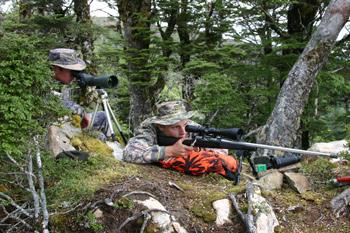
Jamie lining up on a sika hind at 700 yards in the Western Kawekas. I am on the 80mm Swarovski spotter.
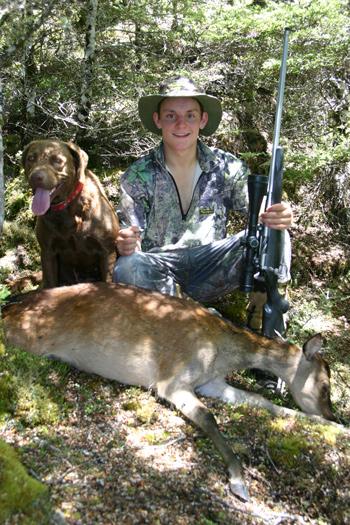
And the result! You'll notice the muzzle brake is off for spook and shoot mode in the bush when you don't have time to use hearing protection. Quite surprisingly, the point of impact hardly shifted with the muzzle brake removed.
None of this is rocket science; it is simply due to case capacity. Despite the short magnums' fatter cases, they still fall short of the standard length magnums' powder capacity. This is not an issue with factory ammunition. In fact, Federal's 7mm WSM velocities are on average 100 fps faster than their 7mm Remington Magnum ballistics with the same bullet weight. Obviously the ammunition companies are downloading the standard magnums to make the short magnums more attractive, so if you're purchasing a rifle to shoot factory ammunition, I know which one I'd be buying! With a shorter lighter rifle, better ballistics and a good selection of bullet weights and types, choosing between the WSM and the Remington Magnum for the factory ammo shooter is a no-brainer!
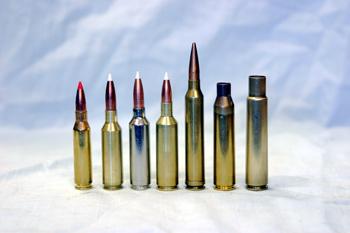
From the left: 7mm/08; 7mm SAUM; 7mm WSM; 7mm Fatso; 7mm STW; 338 Lapua Magnum; 416 Rigby. Based on a shortened and improved 338 Lapua Magnum, the 7mm Fatso gives 7mm STW ballistics in a short action.
Always trying to invent a better mousetrap and with a love of hunting the high and remote places, my son Jamie and I talked about what would be the ultimate lightweight hunting rifle capable of flattening our largest deer up close and personal on out to the long shots sometimes required in our big country. Setting ourselves a maximum all up including scope rifle weight of 7 pounds meant we would have to save weight wherever we could if we still wanted to have a barrel heavy enough to ensure excellent accuracy. Jamie already had a short action Remington Titanium and this seemed the ideal starting point to meet our light and compact criteria. The calibre was a foregone conclusion as the 7mm still provides the best compromise of ballistics versus recoil in lightweight rifles for our big game animals. But what case design would give those 7mm bullets the most velocity out of the short action? We wanted to see if we could come up with something that would get close to 7mm STW ballistics.
This full length cartridge is a superb long-range performer and is ballistically about halfway between the 7mm Magnum and my 7mm/404 wildcats or the 7mm RUM. The 7mm STW achieves 3200 fps with the 160 grain bullets we wanted to use, whereas the current short action velocity king, the 7mm WSM, produces just over 3000 fps with that bullet weight. We were going to need a lot more than WSM case capacity to achieve our objectives. Increasing case length wasn't an option as the WSM is already too long for an unmodified 700 short action, requiring magazine and bolt throw modifications to seat the bullets out to the lands for best accuracy. That only left using a fatter case, but the WSM's .550 inch base diameter was going to take some beating. Width wise the next step up the ladder was the 1911 vintage 416 Rigby and its more recent derivatives the 378 Weatherby and the 338 Lapua Magnum with their .585 - .590 inch base diameter. After some calculations it looked like a 35° shouldered version with a body length the same as the 7mm WSM would give us about the same capacity as the STW, leaving the question would the Remington 700 action handle the increased bolt thrust that a large diameter case like this generates?

Comparing calculations of locking lug surface area and shear strength, the Remington came out slightly ahead of the Mark V Weatherby action which has been offered in the 378 Weatherby and related chamberings since 1955. We decided therefore that this would be okay although we would keep tabs on locking lug setback by monitoring any changes in headspace. The other issue with a case of this diameter is the size of the barrel shank. At peak chamber pressure, the barrel shank expands and then returns to its original size due to not exceeding the steel's yield strength and elasticity. The brass cartridge case also expands but does not quite return to its original size due to its yield strength (about 7000 psi) having been exceeded, slightly wedging it in the chamber. This varies depending on how many times a case has been fired as the brass slowly loses its elasticity with repeated firings and sizings, increasing the wedging. When you lift the bolt, the leverage exerted by the primary extraction allows you to move the fired case rearwards enough to loosen it in the chamber due to the tapered chamber walls. The thinner the barrel shank around the chamber, the more it will expand before returning to size. The cartridge case therefore expands more as well, the wedging increases and the further rearward you will need to extract the case before it comes free. If the rearward movement required becomes more than the primary extraction provided by the action, you'll have difficulty pulling back the bolt after you have opened it. The Remington 700 has a 1.0625 inch barrel shank the same as the Weatherby Mark V, but being a two lug action it has a 90° bolt lift which gives more primary extraction than the three sets of lugs and 60° bolt lift of the Mark V. As there haven't been any significant problems with the Mark V, we decided our extraction would be okay.
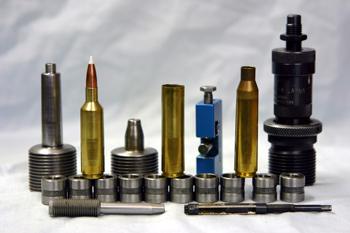
Most of the equipment necessary to form Fatso cases. The short starter and long expander mandrels can be seen in behind; the Neil Jones form die on the right; the eight bushings required for necking down the expanded and thinned case are middle left, the two neck sizing and shoulder bump bushings are middle right; the neck expander for neck turning is front left and the neck inside reamer is front right ; the blue neck turner is at the back ; 338 Lapua Magnum case at right ; shortened, expanded and thinned case in middle; 7mm Fatso loaded round with 160 grain Nosler Accubond on left.
Happy now that our action would handle the 416 Rigby family's base diameter, we looked at which of the family members we would use as our parent case. The obvious choice was the 338 Lapua Magnum due to the superb Lapua brass. The other options were the 416 Rigby itself or the big Weatherby, with Norma making the brass for both of these. The Norma brass although very accurate tends to be softer in the head area and the case life is shorter when loaded to the same pressure. The Lapua brass is also superbly accurate and is much harder in the head area, the only disadvantage being it has a very thick web which reduces case capacity somewhat. Settling on the Lapua, we finalised our reamer dimensions, using the same body length and shoulder angle as the 7mm WSM but extending the neck out to .350 inch as we had plenty of brass to play with. I prefer a long neck to keep the burning powder granules and gases deflecting off the shoulder further away from that most important throat area. Dave Manson of Manson reamers did his usual superb job of producing a quality set of floating pilot reamers and headspace gauges and had them out to me inside a month. Dave is the expert when it comes to these large case wildcats. Another reamer manufacturer I tried previously used blanks that are too small for this job causing chattering problems when chambering. I got Neil Jones of Custom Products to make a large diameter case forming die with eight bushings to progressively form the cases. Due to the large case diameter, we opted to use a 1 inch blank for the die body which meant making a 1 1/4" to 1" threaded bush to replace the usual 7/8" bush in the loading press.
While waiting for a new order of barrels to arrive from Dan Lilja in Montana, we opened up the 7mm SAUM chamber on the factory Titanium barrel with the new reamers to make sure the concept was going to work. We also opened up the bolt face and fitted a Sako style extractor designed to work with the 338 LM. We extended rearward the magazine cut out in the bottom of the receiver, shortened the bolt stop to lengthen bolt throw and fitted a Wyatt extended mag box. We opened up the feed rails slightly to allow the fatter case through but this was the only feeding modifications needed as the Wyatt Mag box has its own centre feed lips. A one-piece Weaver aluminum base was epoxied on, Nightforce aluminum/titanium 30 mm rings lapped and a 4.5-14x50 Mark 4 Leupold fitted.
We then formed up some cases which entailed the eight step neck and shoulder forming operation followed by trimming to length, an inside reaming and outside neck turning, and then fire forming. Extraction was difficult with heavy initial bolt lift, not due to the possible issues raised above, but caused by the hard and thick brass that was now formed into the new shoulder. Annealing alleviated the problem somewhat but we still had to excessively bump the shoulder back in a special die we made after each firing. This excessive sizing would eventually lead to case head separations, so we decided there had to be a better way. Thinning down the brass where the new shoulder was going to form seemed to be the only solution so we made up a set of inside expanders and turning mandrels. We set it up so we could take a simple parallel cut with the lathe reducing the case wall down to a thickness more suitable for the shoulder area. These thinned cases were then formed up as before and this solved any extraction problems with the fired cases just falling out.
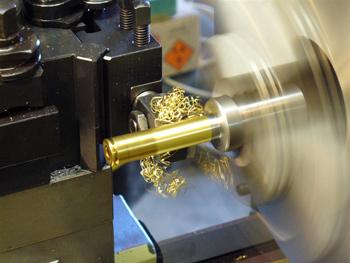
Turning the expanded and shortened case to reduce the brass thickness where the new shoulder will form.
Initial load development proved interesting as the hard Lapua brass didn't show the usual pressure signs, so we were very conservative while working up loads. We chose the Hornady 162 grain A-Max as an accurate long-range bullet to begin with, and were pleased to achieve 3200 fps with the 24 inch factory barrel. This was with the new ADI 2225/Retumbo which proved to have about the perfect burning rate of any of the extruded powders in this case. It looked like we would equal 7mm STW velocities in the same length barrel which was our original objective. Surprisingly, the factory barrel held half MOA accuracy most of the time, a testament to the quality of the barrels Remington put on their Titanium's – or this one at least!
After the initial range work was completed and drop chart generated, Jamie was busting a gut to kill something with the new round which at this stage we called the 7mm LSM (Lapua Short Magnum). It was time for our annual school holiday trip into the mountain beech area of the Kaweka Mountains. Jamie pulled off a magnificent 650 yard shot holding one mildot (approx 3.5 MOA) of windage to kill a Sika hind on his favourite clearing on a windy day; a great way to blood a new cartridge! The following day he also shot a dry hind at close range while stalking the bush edge, before an easterly storm finished our trip early.
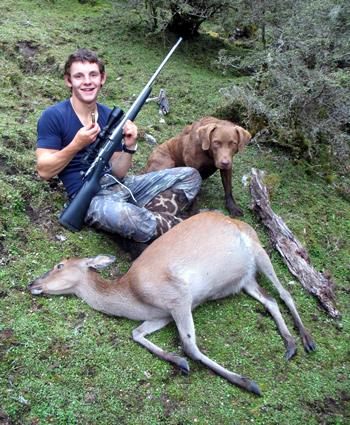
The first game animal taken with the 7mm Fatso, original factory barrel. A sika hind shot at 650 yards in the mountain beech area of the Kawekas.
With the roar (rut) approaching and the new barrel still on the water, we thought we'd better develop a load for larger deer at close range. Of the controlled expansion type hunting bullets, the factory barrel seemed to like 160 grain Speer Grandslams best. A moderate load achieved 3150 fps with accuracy around one MOA giving suitable performance out to over 300 yards.
The first roar trip for the rifle was a wander around the bush out the back of my uncle's farm. While the population of red deer is fairly low, you can encounter the odd animal especially during the roar when the stags are advertising their presence. Early one Saturday morning, we had made our way to a good knob to listen from and were pleasantly surprised to get a reply to my first red roar for the year. Making our way through kanuka scrub to a gorgy area about where we thought the reply had come from, I gave another roar and spied a set of antlers moving in the scrub on the next ridge. Looking through our binos we could see he had a fair bit of antler up and was definitely worth shooting. Just then he moved off heading up the ridge and we thought he must have twigged us so we raced off on the parallel ridge trying to catch up. At a dip in the ridge we heard a crash on the right and it turned out he'd been making his way across the gully to us. Now we had spooked him, so I roared to try and stop him. This worked and he paused as he crested his own ridge 100 yards away. Jamie thought he could see enough of him and wasted no time in dropping down and shooting off his knees. The shot had the desired result, so we made our way over to find he'd secured an uneven 12 pointer, but much better than we'd expected from this area. He had a large body in very good condition so we got all of him out and he made wonderful sausages!
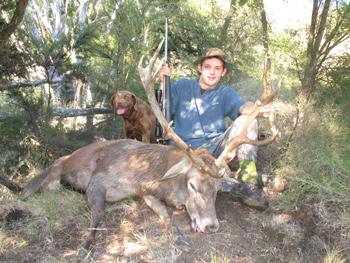
Jamie and an uneven 12 pointer, the first red stag to fall to the 7mm Fatso. Taken with a 160 grain Speer GrandSlam at 100 yards across a gully in Big Kanuka.
After that I was so busy guiding on sika that the boys had to make their own arrangements. On a fly camping trip into the Southern Kaimanawa Wilderness Area, they shot a lovely eight point sika – a combined effort with Willie hitting it first with a hurried shot with his 25/284 as the stag departed. Then Jamie followed him up on the run and finished the job with the Fatso.
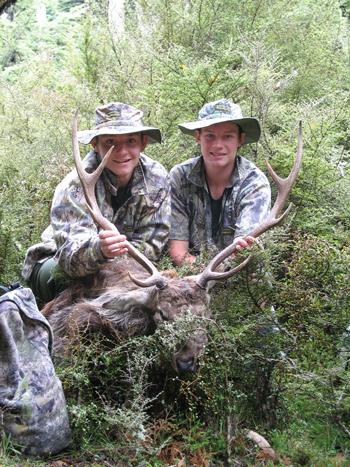
The boys and their trophy 8 point sika stag
My good friend and accountant Ian Lyver was doing a May trip into the wapiti country after the bugle with his son Phil, and Jamie loaned them his rifle. After making their way up to the Edith saddle, Ian and Phil spent a few days hunting in the vicinity. One day while making their way up the large terraces that lead to Oilskin Pass, they encountered a pretty good 13 point crossbreed chasing some cows. The wapiti had got their wind and were departing but the bull paused on the edge of a ledge over 300 yards away. Ian dropped him only to have him fall over a bluff and smash the bey tines right off. Such is luck!
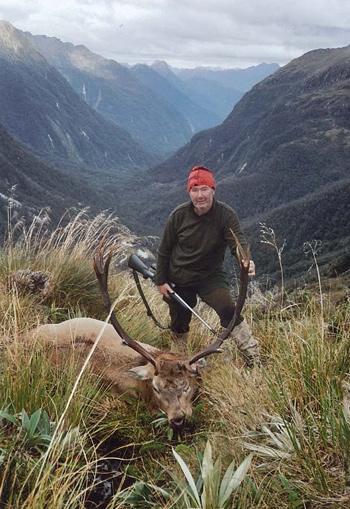
Ian Lyver with his wapiti with the Edith Valley in the background. The bull fell over a bluff after the shot and smashed tines and broke his nose.
Finally the new barrel order arrived, including a 26 inch fluted number 4 contour stainless match earmarked for Jamie's rifle. We set to and trued the Titanium action and then fitted and chambered the barrel. We fitted a 3 lever Jewel trigger and bedded the barreled action into one of McMillan Hunters Edge lightweight carbon fiber rifle stocks. Then a Nightforce NXS 5.5-22x56 scope was installed for testing purposes.

After the one shot and clean barrel break in (which took eight rounds for the barrel to stop copper fouling), the serious load development began. This time we used an Oehler 43 ballistic laboratory with a strain gauge fitted on top of the barrel above the chamber area to monitor pressure precisely. We started with the 162 grain A-Max that had performed well in the factory barrel and this time the top velocity producer was Hodgdon's H870 ball powder with maximum loads approaching 3300 fps. Next we tried Berger's 180 grain VLD which with the same powder achieved 3100 fps. Lastly we tested 160 grain Nosler Accubond's seated to fit in the magazine and pushed up to 3300 fps as an all-round big game load.
Accuracy wise the A-Max's and Berger's both averaged better than .4" at 100 yards, while the Accubond big game magazine loads managed better than .6" even though they were jumping a long way to the rifling. They also shot to the same point of impact as the others which was a lucky bonus.
Now it was down to the long range testing to see whether the A-Max or the Berger would be chosen for the distance work. They both shot extremely good groups at 600 and 1000 yards averaging half MOA with very little vertical in them. The BC's worked out to be .650 for the A-Max and .685 for the Berger out of this barrel, which ballistically gave the edge to the A-Max due to the 200 fps extra velocity. This is the lowest BC I have ever got for the 180 Berger which is unusual as out of some of my barrels it works out at over .700, proving that all barrels can be a law unto themselves.
Lastly accuracy tests off a bipod were conducted which proved acceptable so long as you had a hand firmly upfront. Even with the big heavy Nightforce on top, the all up rifle weight was still under 8 pounds which made it quite lively on the bench especially when testing the heavyweight 180 grain VLD's. We decided to fit a Vais muzzle brake so turned a custom thread at muzzle diameter (.650") on the barrel and threaded the muzzle brake to suit. This changed the personality of the rifle completely and you could now shoot it very accurately with your left-hand under the butt which I prefer in the field.
Interestingly, the point of impact hardly changed at all and you could easily interchange from the aluminium thread protector which is easier on the ears for walking and stalking, to the muzzle brake for long-range sniping when you've got time to use earplugs.
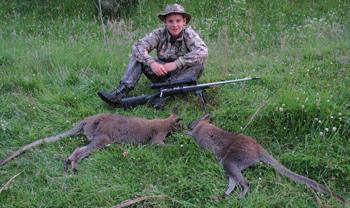
Use enough gun! Although a little unnecessary for wallabies, the Fatso made short work of these at 600 yards.
With drop charts done once more it was time to go hunting! We headed off on a quick trip to the South Island for the whole family over the summer holidays to have a look around Canterbury University where Jamie was enrolling and to squeeze in a bit of hunting. After leaving Christchurch, we headed up the Godley for a flying visit to see some Himalayan tahr, enduring midday temperatures approaching 40°C (104°F) in the high country. No mature bulls were seen on public land and we left the young bulls to grow but the boys had some fun climbing the bluffs and shooting a few nannies while mum watched from the valley floor.
A good friend Duncan took us for a quick look for a wallaby one evening near the Hunter Hills and the boys sniped four around 600 yards with their lightweight hunting rifles while I spotted for them. What great sport these were and I wished I'd brought along my 240 Gibbs long range varmint rifle! Heading north, we had one night in North Canterbury chamois country, but got there a little late for an evening hunt.
The next morning I pointed the boys up a likely looking valley while Fi and I packed up camp to make sure we made the ferry crossing back to the North Island later that day on time. After an hour the boys radioed up to say they hadn't seen anything and what do these chamois looked like anyway? Five minutes later they radioed back to say James had spied one on some bluffs at the head of the valley and they were heading off on a stalk.
Twenty minutes later a shot echoed down the valley and they radioed up to say they thought Jamie had shot a good buck but they were off to stalk another one they had seen. A little while later more shooting was heard and eventually both boys appeared carrying a chamois head each. Jamie had shot a lovely 9 1/2 inch buck with great hooks at 420 yards and then Willie had used Jamie's rifle to shoot a nanny at 575 yards on top of a bluff. Both boys were very pleased with yet another new species under their belt.
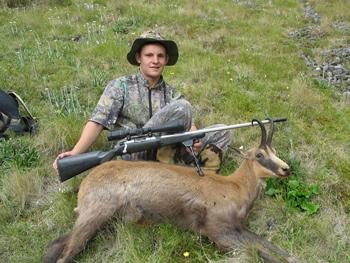
A 9 1/2 inch buck, not bad for your first chamois!
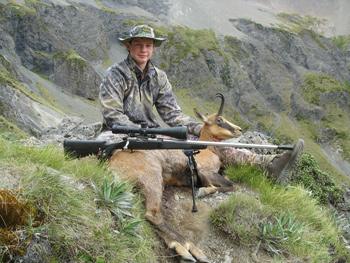
Willie and his first chamois. 162 grain A-Max load at 575 yards.
After a week at home to tidy up some work, we flew in with Heli-Sika on our annual school holiday trip into the Kaweka mountain beech area. We were sharing the area with Sam Bindon and his 10-year-old son Matt who had flown in with another operator. Willie had a couple of mates along as well so night times in the hut were very entertaining! The first deer to fall to Jamie's rifle was on the second morning when we had spotted a yearling asleep on a tiny clearing while a couple of hinds were sunning themselves on a bush knob higher up 600 yards away. Sam shot the yearling with Willie's 25/284 and then Jamie quickly dropped one of the hinds before they disappeared into the bush.
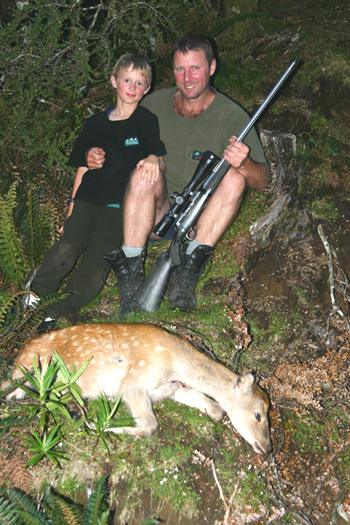
Sam Bindon and his 10-year-old son Matt with Sam's sika.
Later the next day after 3 fell to other rifles, Jamie spied another hind as she appeared briefly on a waterfern clearing 700 yards away not long before dark with no time to get closer. A careful shot later and it was two for two for the new gun. On our last day while hunting in a new area, Jamie pulled off a wonderful shot at 760 yards during a brief clearance in the heavy cloud we experienced that day. The 162 grain A-Max load performed superbly in sometimes windy conditions with one shot kills every time.
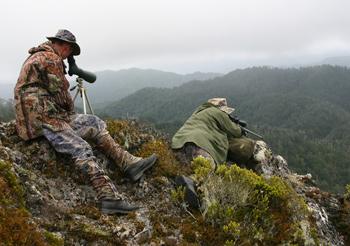
The longest shot so far for the 7mm Fatso - a sika at 760 yards on our last day during a clearance in the cloud.
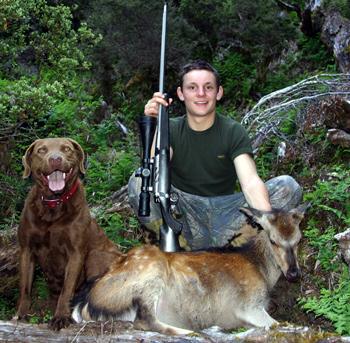
And again the result!
So has this new wildcat lived up to our original aims and objectives? Ballistically it equals the 7mm STW but in a shorter and lighter rifle. The 160 grain Accubond load is very versatile and capable of killing any game animal in New Zealand across a wide variety of ranges. For the specialist long-range applications, the 162 grain A-Max load has proved to be an excellent choice as well. By utilizing a short Remington Titanium action, McMillan's excellent rigid yet lightweight Hunters Edge stock, a fluted 26 inch number 4 contour barrel and lightweight alloy/titanium rings, we managed to keep the bare rifle weight under 6 pounds. With the addition of the new VX7 3.5-14x50 mm Leupold scope, the all up rifle weight is just over 7 pounds, making this a superbly portable rifle with quite amazing capabilities.

Have any issues arisen during the development and subsequent year of field testing of this rifle/cartridge combination? We have been monitoring headspace since fitting the Lilja barrel and it has not changed, so lug setback has not been an issue. The extraction problem with the thick brass was an issue until we turned the excess off. This is extra work but the Lapua cases have lasted 20 reloads, so I personally think the time invested is worth it. We formed up some cases out of shortened 30/378 Weatherby brass with the belt turned off and although we were able to achieve more than 50 fps extra velocity for the same pressure due to the larger internal capacity, the case life was half that of the Lapua brass. We now use US869 powder for both loads and it is producing the same velocity and accuracy with less of the velocity variation at temperature extremes that H870 is known for.
Now that Norma has released their new standard length 2.5 inch magnums based on shortened 416 cases, there is another option. These new parent cases I think will make forming Fatso brass a lot easier, and will eliminate the full length turning procedure and reduce the number of forming operations. I have some 338 Norma Magnum cases on order and will report back once I've tried them. They will be softer in the head and won't last as long as the Lapua, but the ease of manufacture may well make up for that I think. We have now made some 6.5mm versions and they are proving capable of pushing the 140 grain Bergers and 142 grain SMK's at 3350 to 3400 fps. More to come on these.
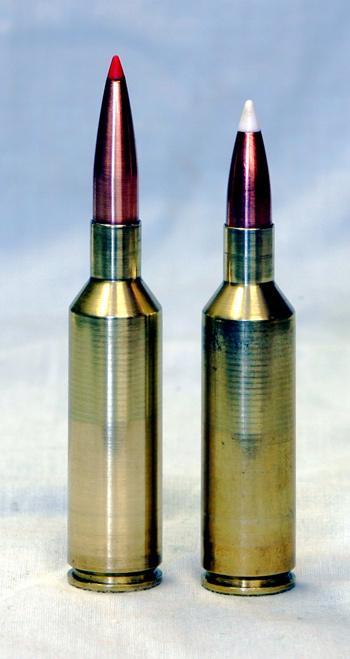
The two loads we settled on for the 7mm Fatso, Hornady 162 grain A-Max doing 3250 fps for the distance work and the Nosler 160 grain Accubond doing 3275 fps as an all-round hunting load.
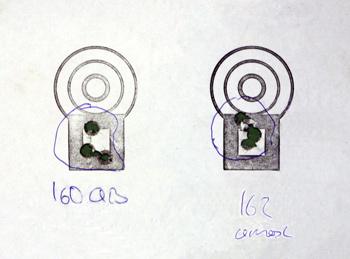
Both loads shot to the same point of impact at 100 yards which was very fortunate.
The field testing has been fairly extensive with 12 animals from 5 different big game species falling to the new rifle/cartridge combination in the first year. At ranges from 80 out to 760 yards, from the Kaimanawas to Fiordland, from Sika to Wapiti, with all the extremes of weather that our high country is renown for thrown in, it has passed the test with flying colours!
Lastly, what have we named this new wildcat? We initially called it the 7mm LSM as I've said, but when good friend Neville Alexander and his son Bruce were down from Northland, Bruce was looking at one of the cases and said "Man that's a fat case, you've got to call it the 7mm Fatso!" Politically correct or not, that's the name that has stuck, the 7mm Fatso it is!
Greg Duley is editor of NZ Hunter magazine, the number one selling hunting magazine in New Zealand. He and sons Jamie and Willie, and wife Fiona are one of the most passionate and dedicated hunting families in NZ. Greg is renowned as the long range hunting expert in his part of the world.
by Greg Duley
©Copyright, NZ Hunter Magazine
The short magnum craze has taken the gun world by storm, with most manufacturers now producing rifles and ammunition for these cartridges. Based on the old British medium bore African cartridge, the 404 Jeffrey, these modern beltless cartridge designs are supposed to give you 2.5 inch case length medium magnum ballistics out of a short action, compact and lightweight hunting rifle. In factory ammunition they achieve this goal by loading the short magnums to higher pressures or by using the latest progressive burning powders. Handloading ammunition to the same pressure with the same powders in the same barrel length, the 7mm SAUM falls 100 fps short of the 1962 vintage 7mm Remington Magnum while the 7mm WSM drops about 50 fps short. When comparing the 300 short magnums with the 300 Winchester Magnum, they fall further behind due to the 300 WM's 2.62 inch case length, which is longer than the other medium magnum's.

Jamie lining up on a sika hind at 700 yards in the Western Kawekas. I am on the 80mm Swarovski spotter.

And the result! You'll notice the muzzle brake is off for spook and shoot mode in the bush when you don't have time to use hearing protection. Quite surprisingly, the point of impact hardly shifted with the muzzle brake removed.
None of this is rocket science; it is simply due to case capacity. Despite the short magnums' fatter cases, they still fall short of the standard length magnums' powder capacity. This is not an issue with factory ammunition. In fact, Federal's 7mm WSM velocities are on average 100 fps faster than their 7mm Remington Magnum ballistics with the same bullet weight. Obviously the ammunition companies are downloading the standard magnums to make the short magnums more attractive, so if you're purchasing a rifle to shoot factory ammunition, I know which one I'd be buying! With a shorter lighter rifle, better ballistics and a good selection of bullet weights and types, choosing between the WSM and the Remington Magnum for the factory ammo shooter is a no-brainer!

From the left: 7mm/08; 7mm SAUM; 7mm WSM; 7mm Fatso; 7mm STW; 338 Lapua Magnum; 416 Rigby. Based on a shortened and improved 338 Lapua Magnum, the 7mm Fatso gives 7mm STW ballistics in a short action.
Always trying to invent a better mousetrap and with a love of hunting the high and remote places, my son Jamie and I talked about what would be the ultimate lightweight hunting rifle capable of flattening our largest deer up close and personal on out to the long shots sometimes required in our big country. Setting ourselves a maximum all up including scope rifle weight of 7 pounds meant we would have to save weight wherever we could if we still wanted to have a barrel heavy enough to ensure excellent accuracy. Jamie already had a short action Remington Titanium and this seemed the ideal starting point to meet our light and compact criteria. The calibre was a foregone conclusion as the 7mm still provides the best compromise of ballistics versus recoil in lightweight rifles for our big game animals. But what case design would give those 7mm bullets the most velocity out of the short action? We wanted to see if we could come up with something that would get close to 7mm STW ballistics.
This full length cartridge is a superb long-range performer and is ballistically about halfway between the 7mm Magnum and my 7mm/404 wildcats or the 7mm RUM. The 7mm STW achieves 3200 fps with the 160 grain bullets we wanted to use, whereas the current short action velocity king, the 7mm WSM, produces just over 3000 fps with that bullet weight. We were going to need a lot more than WSM case capacity to achieve our objectives. Increasing case length wasn't an option as the WSM is already too long for an unmodified 700 short action, requiring magazine and bolt throw modifications to seat the bullets out to the lands for best accuracy. That only left using a fatter case, but the WSM's .550 inch base diameter was going to take some beating. Width wise the next step up the ladder was the 1911 vintage 416 Rigby and its more recent derivatives the 378 Weatherby and the 338 Lapua Magnum with their .585 - .590 inch base diameter. After some calculations it looked like a 35° shouldered version with a body length the same as the 7mm WSM would give us about the same capacity as the STW, leaving the question would the Remington 700 action handle the increased bolt thrust that a large diameter case like this generates?

Comparing calculations of locking lug surface area and shear strength, the Remington came out slightly ahead of the Mark V Weatherby action which has been offered in the 378 Weatherby and related chamberings since 1955. We decided therefore that this would be okay although we would keep tabs on locking lug setback by monitoring any changes in headspace. The other issue with a case of this diameter is the size of the barrel shank. At peak chamber pressure, the barrel shank expands and then returns to its original size due to not exceeding the steel's yield strength and elasticity. The brass cartridge case also expands but does not quite return to its original size due to its yield strength (about 7000 psi) having been exceeded, slightly wedging it in the chamber. This varies depending on how many times a case has been fired as the brass slowly loses its elasticity with repeated firings and sizings, increasing the wedging. When you lift the bolt, the leverage exerted by the primary extraction allows you to move the fired case rearwards enough to loosen it in the chamber due to the tapered chamber walls. The thinner the barrel shank around the chamber, the more it will expand before returning to size. The cartridge case therefore expands more as well, the wedging increases and the further rearward you will need to extract the case before it comes free. If the rearward movement required becomes more than the primary extraction provided by the action, you'll have difficulty pulling back the bolt after you have opened it. The Remington 700 has a 1.0625 inch barrel shank the same as the Weatherby Mark V, but being a two lug action it has a 90° bolt lift which gives more primary extraction than the three sets of lugs and 60° bolt lift of the Mark V. As there haven't been any significant problems with the Mark V, we decided our extraction would be okay.

Most of the equipment necessary to form Fatso cases. The short starter and long expander mandrels can be seen in behind; the Neil Jones form die on the right; the eight bushings required for necking down the expanded and thinned case are middle left, the two neck sizing and shoulder bump bushings are middle right; the neck expander for neck turning is front left and the neck inside reamer is front right ; the blue neck turner is at the back ; 338 Lapua Magnum case at right ; shortened, expanded and thinned case in middle; 7mm Fatso loaded round with 160 grain Nosler Accubond on left.
Happy now that our action would handle the 416 Rigby family's base diameter, we looked at which of the family members we would use as our parent case. The obvious choice was the 338 Lapua Magnum due to the superb Lapua brass. The other options were the 416 Rigby itself or the big Weatherby, with Norma making the brass for both of these. The Norma brass although very accurate tends to be softer in the head area and the case life is shorter when loaded to the same pressure. The Lapua brass is also superbly accurate and is much harder in the head area, the only disadvantage being it has a very thick web which reduces case capacity somewhat. Settling on the Lapua, we finalised our reamer dimensions, using the same body length and shoulder angle as the 7mm WSM but extending the neck out to .350 inch as we had plenty of brass to play with. I prefer a long neck to keep the burning powder granules and gases deflecting off the shoulder further away from that most important throat area. Dave Manson of Manson reamers did his usual superb job of producing a quality set of floating pilot reamers and headspace gauges and had them out to me inside a month. Dave is the expert when it comes to these large case wildcats. Another reamer manufacturer I tried previously used blanks that are too small for this job causing chattering problems when chambering. I got Neil Jones of Custom Products to make a large diameter case forming die with eight bushings to progressively form the cases. Due to the large case diameter, we opted to use a 1 inch blank for the die body which meant making a 1 1/4" to 1" threaded bush to replace the usual 7/8" bush in the loading press.
While waiting for a new order of barrels to arrive from Dan Lilja in Montana, we opened up the 7mm SAUM chamber on the factory Titanium barrel with the new reamers to make sure the concept was going to work. We also opened up the bolt face and fitted a Sako style extractor designed to work with the 338 LM. We extended rearward the magazine cut out in the bottom of the receiver, shortened the bolt stop to lengthen bolt throw and fitted a Wyatt extended mag box. We opened up the feed rails slightly to allow the fatter case through but this was the only feeding modifications needed as the Wyatt Mag box has its own centre feed lips. A one-piece Weaver aluminum base was epoxied on, Nightforce aluminum/titanium 30 mm rings lapped and a 4.5-14x50 Mark 4 Leupold fitted.
We then formed up some cases which entailed the eight step neck and shoulder forming operation followed by trimming to length, an inside reaming and outside neck turning, and then fire forming. Extraction was difficult with heavy initial bolt lift, not due to the possible issues raised above, but caused by the hard and thick brass that was now formed into the new shoulder. Annealing alleviated the problem somewhat but we still had to excessively bump the shoulder back in a special die we made after each firing. This excessive sizing would eventually lead to case head separations, so we decided there had to be a better way. Thinning down the brass where the new shoulder was going to form seemed to be the only solution so we made up a set of inside expanders and turning mandrels. We set it up so we could take a simple parallel cut with the lathe reducing the case wall down to a thickness more suitable for the shoulder area. These thinned cases were then formed up as before and this solved any extraction problems with the fired cases just falling out.

Turning the expanded and shortened case to reduce the brass thickness where the new shoulder will form.
Initial load development proved interesting as the hard Lapua brass didn't show the usual pressure signs, so we were very conservative while working up loads. We chose the Hornady 162 grain A-Max as an accurate long-range bullet to begin with, and were pleased to achieve 3200 fps with the 24 inch factory barrel. This was with the new ADI 2225/Retumbo which proved to have about the perfect burning rate of any of the extruded powders in this case. It looked like we would equal 7mm STW velocities in the same length barrel which was our original objective. Surprisingly, the factory barrel held half MOA accuracy most of the time, a testament to the quality of the barrels Remington put on their Titanium's – or this one at least!
After the initial range work was completed and drop chart generated, Jamie was busting a gut to kill something with the new round which at this stage we called the 7mm LSM (Lapua Short Magnum). It was time for our annual school holiday trip into the mountain beech area of the Kaweka Mountains. Jamie pulled off a magnificent 650 yard shot holding one mildot (approx 3.5 MOA) of windage to kill a Sika hind on his favourite clearing on a windy day; a great way to blood a new cartridge! The following day he also shot a dry hind at close range while stalking the bush edge, before an easterly storm finished our trip early.

The first game animal taken with the 7mm Fatso, original factory barrel. A sika hind shot at 650 yards in the mountain beech area of the Kawekas.
With the roar (rut) approaching and the new barrel still on the water, we thought we'd better develop a load for larger deer at close range. Of the controlled expansion type hunting bullets, the factory barrel seemed to like 160 grain Speer Grandslams best. A moderate load achieved 3150 fps with accuracy around one MOA giving suitable performance out to over 300 yards.
The first roar trip for the rifle was a wander around the bush out the back of my uncle's farm. While the population of red deer is fairly low, you can encounter the odd animal especially during the roar when the stags are advertising their presence. Early one Saturday morning, we had made our way to a good knob to listen from and were pleasantly surprised to get a reply to my first red roar for the year. Making our way through kanuka scrub to a gorgy area about where we thought the reply had come from, I gave another roar and spied a set of antlers moving in the scrub on the next ridge. Looking through our binos we could see he had a fair bit of antler up and was definitely worth shooting. Just then he moved off heading up the ridge and we thought he must have twigged us so we raced off on the parallel ridge trying to catch up. At a dip in the ridge we heard a crash on the right and it turned out he'd been making his way across the gully to us. Now we had spooked him, so I roared to try and stop him. This worked and he paused as he crested his own ridge 100 yards away. Jamie thought he could see enough of him and wasted no time in dropping down and shooting off his knees. The shot had the desired result, so we made our way over to find he'd secured an uneven 12 pointer, but much better than we'd expected from this area. He had a large body in very good condition so we got all of him out and he made wonderful sausages!

Jamie and an uneven 12 pointer, the first red stag to fall to the 7mm Fatso. Taken with a 160 grain Speer GrandSlam at 100 yards across a gully in Big Kanuka.
After that I was so busy guiding on sika that the boys had to make their own arrangements. On a fly camping trip into the Southern Kaimanawa Wilderness Area, they shot a lovely eight point sika – a combined effort with Willie hitting it first with a hurried shot with his 25/284 as the stag departed. Then Jamie followed him up on the run and finished the job with the Fatso.

The boys and their trophy 8 point sika stag
My good friend and accountant Ian Lyver was doing a May trip into the wapiti country after the bugle with his son Phil, and Jamie loaned them his rifle. After making their way up to the Edith saddle, Ian and Phil spent a few days hunting in the vicinity. One day while making their way up the large terraces that lead to Oilskin Pass, they encountered a pretty good 13 point crossbreed chasing some cows. The wapiti had got their wind and were departing but the bull paused on the edge of a ledge over 300 yards away. Ian dropped him only to have him fall over a bluff and smash the bey tines right off. Such is luck!

Ian Lyver with his wapiti with the Edith Valley in the background. The bull fell over a bluff after the shot and smashed tines and broke his nose.
Finally the new barrel order arrived, including a 26 inch fluted number 4 contour stainless match earmarked for Jamie's rifle. We set to and trued the Titanium action and then fitted and chambered the barrel. We fitted a 3 lever Jewel trigger and bedded the barreled action into one of McMillan Hunters Edge lightweight carbon fiber rifle stocks. Then a Nightforce NXS 5.5-22x56 scope was installed for testing purposes.

After the one shot and clean barrel break in (which took eight rounds for the barrel to stop copper fouling), the serious load development began. This time we used an Oehler 43 ballistic laboratory with a strain gauge fitted on top of the barrel above the chamber area to monitor pressure precisely. We started with the 162 grain A-Max that had performed well in the factory barrel and this time the top velocity producer was Hodgdon's H870 ball powder with maximum loads approaching 3300 fps. Next we tried Berger's 180 grain VLD which with the same powder achieved 3100 fps. Lastly we tested 160 grain Nosler Accubond's seated to fit in the magazine and pushed up to 3300 fps as an all-round big game load.
Accuracy wise the A-Max's and Berger's both averaged better than .4" at 100 yards, while the Accubond big game magazine loads managed better than .6" even though they were jumping a long way to the rifling. They also shot to the same point of impact as the others which was a lucky bonus.
Now it was down to the long range testing to see whether the A-Max or the Berger would be chosen for the distance work. They both shot extremely good groups at 600 and 1000 yards averaging half MOA with very little vertical in them. The BC's worked out to be .650 for the A-Max and .685 for the Berger out of this barrel, which ballistically gave the edge to the A-Max due to the 200 fps extra velocity. This is the lowest BC I have ever got for the 180 Berger which is unusual as out of some of my barrels it works out at over .700, proving that all barrels can be a law unto themselves.
Lastly accuracy tests off a bipod were conducted which proved acceptable so long as you had a hand firmly upfront. Even with the big heavy Nightforce on top, the all up rifle weight was still under 8 pounds which made it quite lively on the bench especially when testing the heavyweight 180 grain VLD's. We decided to fit a Vais muzzle brake so turned a custom thread at muzzle diameter (.650") on the barrel and threaded the muzzle brake to suit. This changed the personality of the rifle completely and you could now shoot it very accurately with your left-hand under the butt which I prefer in the field.
Interestingly, the point of impact hardly changed at all and you could easily interchange from the aluminium thread protector which is easier on the ears for walking and stalking, to the muzzle brake for long-range sniping when you've got time to use earplugs.

Use enough gun! Although a little unnecessary for wallabies, the Fatso made short work of these at 600 yards.
With drop charts done once more it was time to go hunting! We headed off on a quick trip to the South Island for the whole family over the summer holidays to have a look around Canterbury University where Jamie was enrolling and to squeeze in a bit of hunting. After leaving Christchurch, we headed up the Godley for a flying visit to see some Himalayan tahr, enduring midday temperatures approaching 40°C (104°F) in the high country. No mature bulls were seen on public land and we left the young bulls to grow but the boys had some fun climbing the bluffs and shooting a few nannies while mum watched from the valley floor.
A good friend Duncan took us for a quick look for a wallaby one evening near the Hunter Hills and the boys sniped four around 600 yards with their lightweight hunting rifles while I spotted for them. What great sport these were and I wished I'd brought along my 240 Gibbs long range varmint rifle! Heading north, we had one night in North Canterbury chamois country, but got there a little late for an evening hunt.
The next morning I pointed the boys up a likely looking valley while Fi and I packed up camp to make sure we made the ferry crossing back to the North Island later that day on time. After an hour the boys radioed up to say they hadn't seen anything and what do these chamois looked like anyway? Five minutes later they radioed back to say James had spied one on some bluffs at the head of the valley and they were heading off on a stalk.
Twenty minutes later a shot echoed down the valley and they radioed up to say they thought Jamie had shot a good buck but they were off to stalk another one they had seen. A little while later more shooting was heard and eventually both boys appeared carrying a chamois head each. Jamie had shot a lovely 9 1/2 inch buck with great hooks at 420 yards and then Willie had used Jamie's rifle to shoot a nanny at 575 yards on top of a bluff. Both boys were very pleased with yet another new species under their belt.

A 9 1/2 inch buck, not bad for your first chamois!

Willie and his first chamois. 162 grain A-Max load at 575 yards.
After a week at home to tidy up some work, we flew in with Heli-Sika on our annual school holiday trip into the Kaweka mountain beech area. We were sharing the area with Sam Bindon and his 10-year-old son Matt who had flown in with another operator. Willie had a couple of mates along as well so night times in the hut were very entertaining! The first deer to fall to Jamie's rifle was on the second morning when we had spotted a yearling asleep on a tiny clearing while a couple of hinds were sunning themselves on a bush knob higher up 600 yards away. Sam shot the yearling with Willie's 25/284 and then Jamie quickly dropped one of the hinds before they disappeared into the bush.

Sam Bindon and his 10-year-old son Matt with Sam's sika.
Later the next day after 3 fell to other rifles, Jamie spied another hind as she appeared briefly on a waterfern clearing 700 yards away not long before dark with no time to get closer. A careful shot later and it was two for two for the new gun. On our last day while hunting in a new area, Jamie pulled off a wonderful shot at 760 yards during a brief clearance in the heavy cloud we experienced that day. The 162 grain A-Max load performed superbly in sometimes windy conditions with one shot kills every time.

The longest shot so far for the 7mm Fatso - a sika at 760 yards on our last day during a clearance in the cloud.

And again the result!
So has this new wildcat lived up to our original aims and objectives? Ballistically it equals the 7mm STW but in a shorter and lighter rifle. The 160 grain Accubond load is very versatile and capable of killing any game animal in New Zealand across a wide variety of ranges. For the specialist long-range applications, the 162 grain A-Max load has proved to be an excellent choice as well. By utilizing a short Remington Titanium action, McMillan's excellent rigid yet lightweight Hunters Edge stock, a fluted 26 inch number 4 contour barrel and lightweight alloy/titanium rings, we managed to keep the bare rifle weight under 6 pounds. With the addition of the new VX7 3.5-14x50 mm Leupold scope, the all up rifle weight is just over 7 pounds, making this a superbly portable rifle with quite amazing capabilities.

Have any issues arisen during the development and subsequent year of field testing of this rifle/cartridge combination? We have been monitoring headspace since fitting the Lilja barrel and it has not changed, so lug setback has not been an issue. The extraction problem with the thick brass was an issue until we turned the excess off. This is extra work but the Lapua cases have lasted 20 reloads, so I personally think the time invested is worth it. We formed up some cases out of shortened 30/378 Weatherby brass with the belt turned off and although we were able to achieve more than 50 fps extra velocity for the same pressure due to the larger internal capacity, the case life was half that of the Lapua brass. We now use US869 powder for both loads and it is producing the same velocity and accuracy with less of the velocity variation at temperature extremes that H870 is known for.
Now that Norma has released their new standard length 2.5 inch magnums based on shortened 416 cases, there is another option. These new parent cases I think will make forming Fatso brass a lot easier, and will eliminate the full length turning procedure and reduce the number of forming operations. I have some 338 Norma Magnum cases on order and will report back once I've tried them. They will be softer in the head and won't last as long as the Lapua, but the ease of manufacture may well make up for that I think. We have now made some 6.5mm versions and they are proving capable of pushing the 140 grain Bergers and 142 grain SMK's at 3350 to 3400 fps. More to come on these.

The two loads we settled on for the 7mm Fatso, Hornady 162 grain A-Max doing 3250 fps for the distance work and the Nosler 160 grain Accubond doing 3275 fps as an all-round hunting load.

Both loads shot to the same point of impact at 100 yards which was very fortunate.
The field testing has been fairly extensive with 12 animals from 5 different big game species falling to the new rifle/cartridge combination in the first year. At ranges from 80 out to 760 yards, from the Kaimanawas to Fiordland, from Sika to Wapiti, with all the extremes of weather that our high country is renown for thrown in, it has passed the test with flying colours!
Lastly, what have we named this new wildcat? We initially called it the 7mm LSM as I've said, but when good friend Neville Alexander and his son Bruce were down from Northland, Bruce was looking at one of the cases and said "Man that's a fat case, you've got to call it the 7mm Fatso!" Politically correct or not, that's the name that has stuck, the 7mm Fatso it is!
Greg Duley is editor of NZ Hunter magazine, the number one selling hunting magazine in New Zealand. He and sons Jamie and Willie, and wife Fiona are one of the most passionate and dedicated hunting families in NZ. Greg is renowned as the long range hunting expert in his part of the world.

